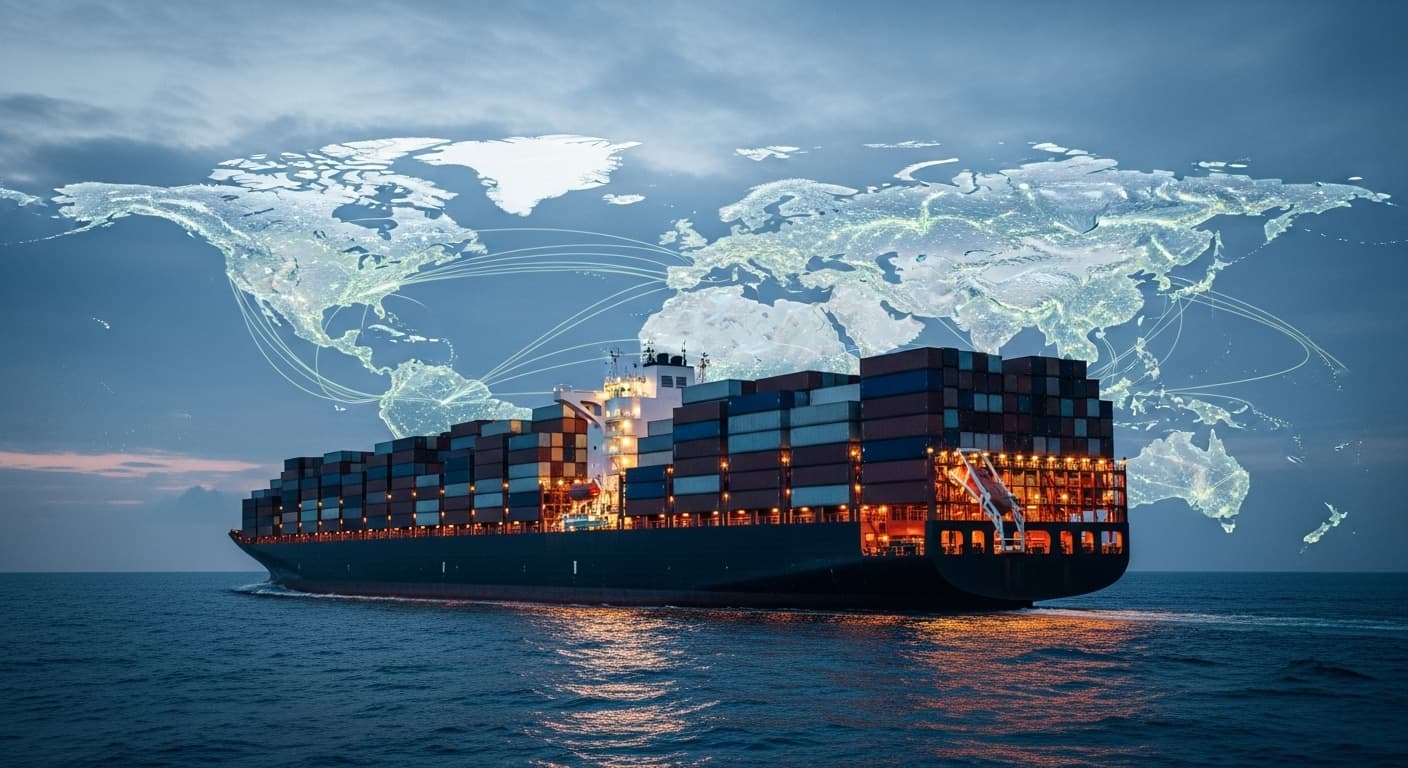
New U.S. port fees on Chinese vessels create unprecedented challenges for import cost management
Executive Summary
The implementation of substantial U.S. port fees targeting Chinese-built, -owned, and -operated vessels beginning October 14, 2025, represents a fundamental shift in trade policy with far-reaching implications for supply chain economics. Despite initial carrier assurances about cost absorption, importers and exporters face escalating fees potentially reaching $2.7 million per voyage, creating urgent needs for strategic planning and risk management.
Chinese Vessel Fees 2025: Navigating the New Era of Policy-Driven Shipping Costs
(中国船舶费用2025:政策驱动运输成本新时代的导航)
The maritime trade landscape faces unprecedented disruption as the United States implements comprehensive port fees targeting Chinese vessels, fundamentally altering the economic dynamics of trans-Pacific commerce. The U.S. Trade Representative’s (USTR) final assessment, taking effect October 14, 2025, introduces fees ranging from $1 million to $2.7 million per large container ship per voyage, creating immediate strategic challenges for importers, exporters, and logistics service providers.
This policy shift extends beyond routine regulatory adjustment to represent a fundamental tool of economic statecraft, transferring geopolitical costs to commercial entities while forcing comprehensive reevaluation of supply chain strategies and cost structures across American international trade.
Understanding the Fee Structure: Comprehensive Regulatory Framework
The USTR’s final assessment, announced April 17, 2025, establishes a complex multi-tiered fee structure designed to “restore American shipbuilding” while addressing “China’s unreasonable acts, policies and practices to dominate the maritime, logistics and shipbuilding sectors.”
Annex I: Chinese Vessel Operators and Owners
The most substantial fees target vessels operated or owned by Chinese entities:
Fee Structure and Escalation Timeline:
- October 14, 2025: $50 per net ton (initial implementation)
- April 17, 2026: $80 per net ton (60% increase)
- April 17, 2027: $110 per net ton (additional 37.5% increase)
- April 17, 2028: $140 per net ton (final 27% increase)
Financial Impact Assessment: For a typical 20,000 net ton container vessel, these fees translate to:
- Initial Cost: $1,000,000 per voyage
- 2028 Maximum: $2,800,000 per voyage
- Three-Year Increase: 180% cost escalation
Annex II: Chinese-Built Vessels
Fees targeting vessels constructed in Chinese shipyards, regardless of current ownership:
Calculation Methodology:
- Base Rate: $18 per net ton
- Container Alternative: $120 per container discharged
- Application Rule: Higher of the two calculations applies
- Escalation Schedule: Annual increases following same timeline as Annex I
Strategic Implications: This structure particularly affects the substantial fleet of Chinese-built vessels operated by international carriers, creating widespread exposure across the global shipping industry beyond Chinese-owned operators.
Annex III: Foreign-Built Vehicle Carriers
Additional fees targeting specialized vehicle transport vessels, expanding scope beyond container shipping to automotive supply chains.
Exemption Categories and Strategic Considerations
Size-Based Exemptions:
- Threshold: Vessels under 4,000 TEU capacity
- Strategic Impact: Potential shift toward smaller vessel deployment
- Capacity Implications: Reduced efficiency and potential capacity constraints
Distance-Based Exemptions:
- Short-Haul Routes: Less than 2,000 nautical miles from foreign port
- Transshipment Opportunities: Potential use of Caribbean hubs (Freeport, Kingston)
- Operational Complexity: Additional handling and transit time requirements
Carrier Response Analysis: Temporary Cost Absorption Strategy
Ocean carriers have adopted a unified public stance of cost absorption while maintaining strategic flexibility for future adjustments.
Current Carrier Position and Market Dynamics
Competitive Market Pressures: The current shipping market environment significantly influences carrier decision-making:
- Overcapacity Conditions: Sustained vessel oversupply limiting pricing power
- Rate Competition: Intense competition constraining ability to impose surcharges
- Customer Retention: Fear that rate increases could result in cargo diversion
- Market Share Protection: Prioritizing volume over margin in competitive environment
Formal Carrier Communications: Most major carriers have issued customer communications stating:
- No Immediate Surcharges: Current plans to absorb fees without customer pass-through
- Future Flexibility: Explicit reservation of rights to impose surcharges later
- Monitoring Provisions: Ongoing assessment of market conditions and fee impact
- Contract Negotiations: Integration of fee considerations into future service agreements
Operational Adjustments and Hidden Costs
Fleet Redeployment Strategies: Carriers have implemented comprehensive vessel rotation programs:
- Chinese-Built Vessel Removal: Systematic redeployment of affected vessels away from U.S. trades
- Route Optimization: Adjustment of service strings to minimize fee exposure
- Capacity Reallocation: Redistribution of vessel capacity across global trade lanes
- Service Frequency: Potential adjustments to sailing schedules and port calls
Operational Efficiency Impact: According to Peter Sand, Chief Analyst at Xeneta, vessel reshuffling creates services that are “no longer operationally optimal,” implying inherent costs including:
- Increased Transit Times: Less efficient routing extending voyage duration
- Port Call Adjustments: Suboptimal port sequences increasing operational costs
- Fuel Consumption: Longer routes and less efficient vessel utilization
- Schedule Reliability: Potential degradation in service consistency and timing
Importer and Exporter Strategic Concerns
Despite carrier assurances, U.S. businesses engaged in international trade express significant concerns about long-term cost implications and operational disruptions.
Long-Term Cost Escalation Risks
Fee Structure Progression Analysis: The escalating fee structure creates predictable cost pressures:

Projected Annex I Fee Escalation ($ per net ton)
Market Tightening Scenarios: Industry analysts anticipate eventual cost pass-through when:
- Market Conditions Improve: Reduced overcapacity enabling carrier pricing power
- Fee Escalation: Higher absolute costs necessitating customer charges
- Competitive Pressures Ease: Market consolidation reducing competitive intensity
- Contract Renewals: Integration of fees into new service agreements
Quote from Industry Expert: Peter Friedmann, Executive Director of the Agriculture Transportation Coalition (AgTC), stated unequivocally that “carriers will have to raise shipping prices eventually,” reflecting widespread industry expectations about future cost pass-through.
Operational Disruption and Service Quality Concerns
Service String Optimization Challenges: Carrier fleet redeployment creates multiple operational concerns:
Schedule Reliability Impact:
- Route Efficiency: Less optimal vessel deployment affecting schedule consistency
- Port Call Sequences: Suboptimal port rotations extending transit times
- Capacity Allocation: Potential mismatches between vessel capacity and market demand
- Service Frequency: Possible reduction in sailing frequency on affected routes
Transshipment Risk Assessment: Potential carrier strategies to minimize fees through Caribbean transshipment:
- Hub Utilization: Increased use of Freeport (Bahamas) and Kingston (Jamaica)
- Additional Handling: Extra cargo handling increasing damage and delay risks
- Transit Time Extension: Additional voyage days affecting inventory planning
- Congestion Risk: Concentrated volume potentially creating port bottlenecks
Capacity Constraint Implications: Shift toward sub-4,000 TEU vessels to avoid fees:
- Reduced Efficiency: Smaller vessels requiring more frequent sailings
- Capacity Limitations: Potential shortage of suitable smaller vessels
- Rate Pressure: Limited capacity potentially supporting rate increases
- Service Coverage: Possible reduction in service frequency or port coverage
Broader Economic Context and Trade Environment
The Chinese vessel fees operate within a complex trade policy environment already experiencing significant disruption and uncertainty.
Tariff Environment and Trade Volume Impact
Import Volume Projections: U.S. import cargo volumes face projected decline for remainder of 2025:
- Tariff Uncertainty: Complex tariff environment affecting sourcing decisions
- Pre-tariff Inventory Depletion: Businesses consuming previously imported inventory
- Sourcing Adjustments: Supplier diversification away from China reducing volumes
- Economic Conditions: Broader economic factors affecting import demand
Pricing Decision Challenges: Businesses struggle with complex pricing environments:
- Cost Structure Uncertainty: Multiple policy-driven cost increases
- Inventory Timing: Decisions about when to rebuild depleted inventory stocks
- Supplier Negotiations: Renegotiating terms with international suppliers
- Customer Price Sensitivity: Balancing cost increases against market acceptance
Logistics Sector Cost Pressures
USPS Holiday Pricing: The U.S. Postal Service announced temporary price increases for 2025 holiday shipping, reflecting broader logistics cost inflation:
- Seasonal Surcharges: Additional costs during peak shipping periods
- Service Provider Alignment: Coordinated industry approach to cost recovery
- Consumer Impact: Direct pass-through of increased logistics costs
- Market Precedent: Demonstration of successful cost recovery strategies
Inflationary Pressure Assessment: Cumulative cost increases across logistics sectors:
- Transportation Costs: Multiple sources of shipping cost increases
- Warehousing Expenses: Increased storage costs affecting inventory strategy
- Labor Costs: Continued wage inflation across logistics workforce
- Technology Investment: Required investment in compliance and efficiency systems
Strategic Implications for Logistics Industry Stakeholders
The implementation of Chinese vessel fees represents a fundamental shift in trade policy with long-term strategic implications extending beyond immediate cost considerations.
Geopolitical Economic Statecraft
Policy Objectives and Trade Strategy: The fees function as tools of economic statecraft designed to:
- Challenge Chinese Dominance: Direct targeting of China’s shipbuilding and maritime sectors
- Restore American Shipbuilding: Creation of competitive advantages for domestic industry
- Supply Chain Diversification: Incentives for businesses to reduce China dependence
- Strategic Competition: Integration of trade policy with broader geopolitical objectives
Risk Allocation Transfer: The policy effectively transfers geopolitical risks to commercial entities:
- Private Sector Burden: Commercial companies absorbing costs of policy objectives
- Risk Externalization: Government policy costs imposed on business operations
- Strategic Uncertainty: Private sector planning complicated by policy unpredictability
- Compliance Complexity: Additional regulatory requirements increasing operational burden
Supply Chain Resilience and Adaptation Requirements
Strategic Planning Imperatives: Businesses must develop comprehensive strategies addressing:
Sourcing Diversification:
- Supplier Base Expansion: Development of alternative supplier relationships
- Geographic Distribution: Spreading sourcing across multiple countries and regions
- Risk Assessment: Evaluation of political and policy risks by country
- Qualification Processes: Establishing quality and capability standards for new suppliers
Transportation Strategy Evolution:
- Carrier Portfolio Management: Diversification across multiple shipping lines
- Route Optimization: Development of alternative transportation corridors
- Service Level Agreements: Contract terms addressing policy-driven cost changes
- Capacity Planning: Long-term capacity requirements considering fee impacts
Financial Risk Management:
- Cost Modeling: Scenario planning for various fee escalation outcomes
- Hedging Strategies: Financial instruments for managing cost volatility
- Budget Planning: Integration of policy risks into financial forecasting
- Pricing Strategy: Customer pricing models reflecting increased cost uncertainty
Industry Response Strategies and Best Practices
Successful navigation of the Chinese vessel fee environment requires comprehensive strategic planning and proactive risk management.
Carrier Relationship Management
Enhanced Communication and Transparency: Businesses should establish systematic communication protocols with shipping providers:
Direct Engagement Strategies:
- Regular Carrier Meetings: Scheduled discussions about fee impact and vessel deployment
- Formal Position Clarification: Written confirmation of carrier policies regarding fee pass-through
- Service Plan Transparency: Understanding of vessel rotation and service adjustments
- Escalation Procedures: Clear protocols for addressing service disruptions or cost changes
Contract Negotiation Enhancement: Future service agreements should address policy-driven cost changes:
- Fee Allocation Clauses: Specific language addressing government-imposed fees and surcharges
- Service Level Guarantees: Maintenance of service quality despite operational adjustments
- Cost Adjustment Mechanisms: Predetermined methods for handling regulatory cost changes
- Performance Incentives: Rewards for maintaining service quality during transitions
Supply Chain Optimization and Diversification
Strategic Sourcing Evolution: Companies should implement comprehensive sourcing strategies:
Supplier Diversification Programs:
- Geographic Distribution: Systematic expansion of supplier base across multiple countries
- Risk Assessment Frameworks: Evaluation criteria including political and regulatory risks
- Qualification Standards: Quality and capability requirements for alternative suppliers
- Relationship Development: Long-term partnership building with new suppliers
Route and Mode Diversification:
- Transportation Corridor Development: Alternative shipping routes reducing single-route dependence
- Modal Integration: Combination of ocean, air, and land transportation options
- Regional Hub Utilization: Strategic use of distribution centers and fulfillment hubs
- Inventory Positioning: Geographic distribution of inventory reducing transportation exposure
Financial Planning and Risk Management
Comprehensive Cost Modeling: Organizations should develop sophisticated financial planning approaches:
Scenario Planning Frameworks:
- Fee Escalation Modeling: Financial impact analysis across different escalation scenarios
- Market Condition Variables: Cost implications under various shipping market conditions
- Operational Adjustment Costs: Hidden costs from service changes and route modifications
- Customer Impact Assessment: Analysis of ability to pass costs through to customers
Risk Mitigation Strategies:
- Cost Hedging Options: Financial instruments for managing transportation cost volatility
- Insurance Coverage: Protection against policy-driven cost increases and disruptions
- Contingency Planning: Operational plans for managing severe cost increases or service disruptions
- Performance Monitoring: Systematic tracking of cost impacts and service quality changes
Long-Term Market Evolution and Industry Transformation
The Chinese vessel fees represent part of broader industry transformation driven by geopolitical considerations and environmental regulations.
Shipping Industry Structural Changes
Fleet Composition Evolution: The fees will likely accelerate changes in global fleet composition:
Vessel Ownership Patterns:
- Flag State Considerations: Potential changes in vessel registration patterns
- Ownership Structure Evolution: Modifications to vessel ownership arrangements
- Leasing Market Development: Enhanced role of vessel leasing in fleet management
- Investment Patterns: Shifts in shipbuilding investment and vessel acquisition
Service Network Optimization: Carriers will continue optimizing networks for policy compliance:
- Route Restructuring: Permanent adjustments to service configurations
- Hub Strategy Evolution: Enhanced use of transshipment hubs outside U.S. jurisdiction
- Capacity Allocation: Strategic deployment of different vessel types across trades
- Alliance Coordination: Enhanced cooperation among carrier alliances for network efficiency
Technology and Innovation Acceleration
Digital Transformation Priorities: Policy complexity accelerates technology adoption:
Compliance Management Systems:
- Regulatory Tracking: Automated monitoring of policy changes and fee structures
- Cost Calculation: Sophisticated modeling of policy impacts on transportation costs
- Route Optimization: AI-driven optimization considering regulatory constraints
- Documentation Management: Comprehensive compliance documentation and reporting
Supply Chain Visibility Enhancement:
- End-to-End Tracking: Complete visibility across complex supply chains
- Predictive Analytics: Forecasting capabilities for policy impact and market changes
- Risk Management Tools: Automated risk assessment and mitigation recommendations
- Customer Communication: Enhanced transparency and communication capabilities
Implementation Timeline and Critical Decision Points
The October 14, 2025 implementation represents the beginning of a multi-year transition requiring ongoing strategic adaptation.
Immediate Implementation Phase (October 2025 - April 2026)
Initial Market Response Assessment: The first six months will reveal actual market dynamics:
- Carrier Cost Absorption: Evaluation of actual carrier ability to absorb costs
- Service Quality Impact: Assessment of operational disruptions and service degradation
- Market Share Shifts: Analysis of cargo volume redistribution among carriers
- Customer Adaptation: Business response to service changes and potential cost increases
Strategic Monitoring Requirements: Organizations should establish systematic monitoring of:
- Carrier Performance: Service quality metrics and schedule reliability
- Cost Structure Changes: Hidden costs from operational adjustments
- Market Conditions: Shipping market evolution affecting carrier pricing power
- Policy Developments: Potential modifications or additional policy measures
Medium-Term Adaptation Phase (April 2026 - April 2028)
Fee Escalation Management: As fees increase substantially, market dynamics will evolve:
- Cost Pass-Through Timing: Likely period for carriers to begin implementing surcharges
- Service Reconfiguration: Major adjustments to shipping networks and service offerings
- Market Consolidation: Potential industry consolidation affecting competitive dynamics
- Alternative Solution Development: Innovation in service delivery and cost management
Strategic Investment Requirements:
- Technology Infrastructure: Enhanced systems for managing complexity
- Supplier Relationships: Investment in alternative supplier development
- Operational Capabilities: Internal capabilities for managing supply chain complexity
- Risk Management: Sophisticated risk management and mitigation capabilities
Long-Term Structural Changes (Post-April 2028)
Industry Equilibrium Development: By 2028, the industry will likely achieve new equilibrium:
- Sustainable Cost Structures: Carriers adapting business models to new cost environment
- Supply Chain Optimization: Businesses completing supply chain diversification
- Technology Integration: Full integration of technology solutions for policy management
- Market Stability: Achievement of new competitive balance reflecting policy environment
Conclusion: Strategic Navigation in Policy-Driven Trade Environment
The implementation of substantial U.S. port fees targeting Chinese vessels represents a watershed moment in international trade policy, fundamentally altering the economics of trans-Pacific commerce and requiring comprehensive strategic adaptation across the logistics industry.
Key Strategic Imperatives
Immediate Action Requirements: Organizations must address immediate challenges while positioning for long-term adaptation:
- Carrier Engagement: Proactive communication and planning with shipping providers
- Contract Management: Enhanced contract terms addressing policy-driven cost changes
- Cost Planning: Comprehensive financial modeling for fee escalation scenarios
- Risk Assessment: Systematic evaluation of operational and financial risks
Long-Term Strategic Positioning: Success requires fundamental adaptation of business models and strategic approaches:
- Supply Chain Diversification: Systematic reduction of single-source and single-route dependencies
- Technology Investment: Enhanced capabilities for managing complexity and optimizing performance
- Relationship Development: Stronger partnerships across diversified supplier and service provider networks
- Financial Resilience: Robust financial planning and risk management capabilities
Market Evolution and Competitive Dynamics
Industry Transformation Acceleration: The fees accelerate existing trends toward supply chain diversification and operational sophistication:
- Geographic Diversification: Enhanced focus on supplier and route diversification
- Technology Adoption: Accelerated investment in digital capabilities and automation
- Service Innovation: Development of new service models addressing policy constraints
- Partnership Strategies: Enhanced collaboration across supply chain participants
Competitive Advantage Development: Organizations that successfully adapt will achieve sustainable competitive advantages:
- Operational Flexibility: Superior ability to adapt to policy changes and market conditions
- Cost Management: Effective management of policy-driven cost increases
- Service Reliability: Maintenance of service quality despite operational complexity
- Customer Relationships: Enhanced value delivery through superior supply chain management
The Chinese vessel fees represent more than a cost increase—they signal a fundamental shift toward policy-driven trade costs that require strategic adaptation and operational excellence. Organizations that recognize this reality and invest appropriately in adaptation capabilities will emerge stronger and more competitive in the evolving international trade environment.
The October 14, 2025 implementation marks the beginning of a multi-year transition requiring sustained strategic focus and operational excellence. Success demands balancing immediate cost management with long-term strategic positioning, ensuring that short-term responses support sustainable competitive advantages while maintaining customer service excellence.
The implementation of Chinese vessel fees represents a significant development in U.S. trade policy with far-reaching implications for international logistics operations. Advanced Logistics Solutions monitors these policy developments closely to provide clients with strategic guidance and operational support for navigating the evolving regulatory environment in international trade and transportation.


